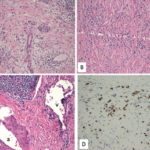Sarcoidosis is a multisystem disease characterized by noncaseating granulomas in affected tissues, mostly involving the lungs and lymph nodes.1,2 The etiology of sarcoidosis remains unknown but is thought to be due to an inflammatory response to an antigen exposure in genetically predisposed individuals.1 Tumor necrosis factor-α (TNF‑α), a pro-inflammatory cytokine, plays an essential role in this inflammatory response leading to the development of granulomas.3 Therapy with TNF-α inhibitors has proved effective for many patients with sarcoidosis.3
Interestingly, some TNF-α inhibitors have been recognized to induce sarcoidosislike disease.4 In 2016, a literature review found 59 cases of sarcoidosis associated with the use of TNF-α inhibitors, with 37 out of 59 associated with etanercept use.5 Fifty-two patients showed partial or complete resolution following discontinuation of the TNF-α inhibitor, either alone or along with steroid administration.
Here, we present a case of a patient with rheumatoid arthritis who developed a sarcoid-like reaction while being treated with etanercept.
Case Presentation
A 29-year-old Black woman with a past medical history of adult-onset Still’s disease (AOSD) and rheumatoid arthritis (RA) was admitted to the emergency department complaining of fever, chills and severe shortness of breath.
Five years prior to this hospitalization—the time of her initial presentation—the patient was admitted to the hospital with fever, pharyngitis, diffuse rash, myalgias, fatigue and a polyarticular arthritis. Laboratory evaluations demonstrated elevated inflammation markers (i.e., erythrocyte sedimentation rate and C-reactive protein), leukocytosis, transaminitis and rheumatoid factor. The creatine kinase was within normal limits, and no anti-nuclear antibodies or anti-citrullinated protein antibodies were detected. A chest X-ray showed no evidence of lymphadenopathy or pulmonary disease.
During the prior hospital admission, a thorough evaluation did not demonstrate evidence of an acute viral, bacterial or fungal infection. She was diagnosed with AOSD based on Yamaguchi classification criteria. She was initially treated with corticosteroids. Because the patient did not respond as anticipated, she was subsequently treated with hydroxychloroquine and methotrexate. Over the following weeks, the patient was also diagnosed with RA based on her positive RF, elevated inflammatory markers and polyarthritis present for greater than six weeks. The rash resolved quickly after diagnosis.
At that earlier time, the primary joints affected were the right third proximal interphalangeal joint and ankles.
During the next 12 months, she was frequently lost to follow-up and took her medications inconsistently.
After one year of therapy with methotrexate and hydroxychloroquine, her rheumatologist initiated 50 mg of subcutaneous etanercept weekly. The response to this treatment was adequate, and she was gradually tapered off methotrexate and hydroxychloroquine. She continued therapy with etanercept for four consecutive years. The patient remained an everyday smoker.


